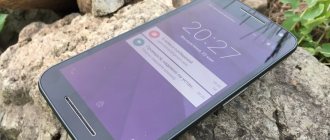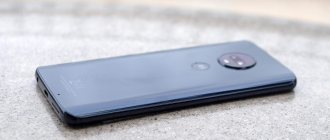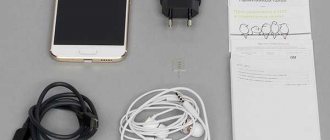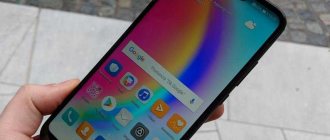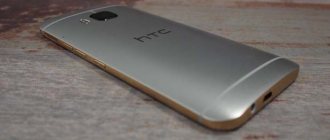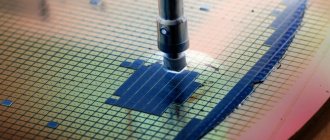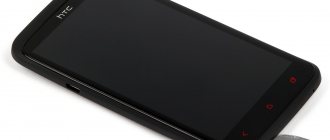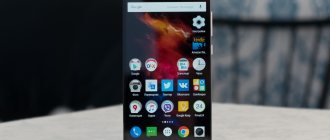A little over a year ago, Motorola's Droid Turbo was released. The device turned out to be extremely successful - it could easily be included in the list of the best smartphones of the year. But was the company able to repeat its success a year later?
Motorola Droid Turbo 2 is a representative of the exclusive line of smartphones for Verizon. But this is only true for the US market. Outside of the States, the model of the sheath can be found under the name Moto X Force.
Minor differences between the Droid Turbo 2 and the Moto X Force are the firmware, pre-installed apps, and Verizon branding (swoosh on the front and Droid on the back).
Starting with this model, the MotoMaker service is available for Droid smartphones. You can read about the pain and suffering that can accompany ordering a custom device on your own in my material about Moto X Style.
Purchase
Soon, smartphones from Moto (including Moto X Force) will be sold by Lenovo in official retail. However, you can get the device in Ukraine, including the American Turbo 2, if you wish. There are even stores that specialize specifically in Motorola products.
It was in such a store that I took the Droid Turbo for review. It's called Motorola-U , they have various models, including some custom ones. Come in, maybe you'll find something to suit your taste.
Specifications
First, let's finish with the formalities.
- Screen : 5.4'' | AMOLED | 2560x1440 | ShatterShield
- Processor : Qualcomm Snapdragon 810 (MSM8994)
- Rear camera : 21 MP, f/2.0 | phase detection autofocus | two-color flash
- Front camera : 5 MP, f/2.0, wide-angle lens
- RAM : 3 GB
- Flash memory : 32/64 GB | microSD memory card slot
- Battery : 3760 mAh, fast charging
- Size : 149.8×78×9.2 millimeters
- Weight : 169 grams
- Features : front stereo speakers, infrared proximity sensors
Hardware platform and software
Motorola's flagship doesn't lack in performance. This is one of the strongest smartphones of last year. So, inside there is an eight-core Qualcomm Snapdragon 810 (MSM8994) processor, Adreno 430 video, 3 GB of RAM and 32/64 GB of storage with expandable memory cards. Naturally, such hardware will be enough for any task. As with all devices with the Snapdragon 810, excessive heating will occur while gaming and watching videos. It won't burn your hands, but it will cause slight discomfort. Test results are expectedly high. A full set of all kinds of sensors and receivers (including wireless charging) is present.
The device runs Android 5.1.1. Motorola does not make any custom launchers, OS. Subjectively, it’s worth using something like Apex to make more efficient use of the free space on such a large display (the launcher allows you to control the desktop grid, with which you can put more icons on the screen and adjust their size).
The smartphone should receive an update to Android Marshmallow, but as the experience of the first Droid Turbo shows, this may happen with a long delay.
Frame
I tested a device with a black plastic back cover and a dark front panel. Leather and ballistic nylon options are also available. Both options can be found in stores or assembled yourself.
As for the design, I would divide this device into two parts. Literally.
From the back, the smartphone looks very nice. Honestly, I like the design of the back cover so much that I would even call it the best one out there. I was actually ready to pick out the camera frame and insert it into my Moto X Style.
But delight quickly gives way to despondency as soon as you turn your smartphone with the screen facing you. Huge frames and not the best display - all this looks a little archaic in 2020. Yes, this is due to the technology of the unbreakable display, but awareness of this fact does not make the smartphone more beautiful.
To briefly describe the overall impressions of the appearance, the Droid Turbo 2 is a beauty and a beast. All in one person.
In terms of tactile sensations, everything is pretty good. The metal frame adds a premium feel over last year's Droid Turbo. At the same time, it is quite difficult to use it with one hand, despite the display diagonal not being the largest by today’s standards. It's all about the width of the smartphone. The same Moto X Style has a narrower body. But its screen is 0.3″ larger.
There are almost no complaints about the assembly. The only thing I can complain about is the card tray, which can protrude out of its slot by a fraction of a millimeter. Nothing special, but still unpleasant.
Motorola Droid Turbo 2 XT1585 review
13 January 2020, 13:45
Today we continue our new series of reviews in pictures and our guest is the top-end smartphone among its fellow Motorola Droid Turbo 2 XT1585 for the American market. In Europe it is called a little differently - Motorola X Force XT1580. Our guest came to us straight from America. He's dressed in a white tailcoat, though it's a little dirty on the road, but I think we'll forgive him for that. But in this surroundings you can clearly see all the features and sensors, the number of which here goes beyond all reasonable limits. The choice of guest was made according to your wishes in a survey conducted in our VKontakte group.
You can view its technical characteristics and inspect it from all sides in the product card, but here we will pay attention to some details.
And so what we see on the front side are as many as four proximity sensors for the “Jedi gesture”, widely known in narrow circles, and scientifically one of the Active Display functions. Front camera flash - what if someone needs it? On the back side, almost invisible even on the white body, there are holes for two of the five microphones available for the active noise reduction system and stereo sound recording in videos.
On the back side, in addition to the material being pleasant to the touch, but very quickly becoming dirty in this color, two points are of interest. The first is the 21 megapixel main camera, which is rightfully considered one of the best among top-end smartphones. And the second point is the dual LED flash, which can be used as a flashlight. It is turned on by a special chopping movement of the wrist. An example of how this function works and how to enable or disable this function can be seen in Settings-Moto. Compared to the Motorola Droid Turbo XT1254, all movements to activate functions work much better, smoother and somehow with ease. The same flashlight on the first Turbo turns on with exactly the same motion, but it seems as if you are actually chopping something. Perhaps the difference in weight has an effect - the second Turbo is much lighter.
Let's pay a little attention to the SIM card tray. Since the back cover is glued to the body, the IMEI is located on the SIM tray. The tray itself does not have latches, as was the case in previous smartphones that snap out the tray. This latch is now located quite deep inside the case itself. Since everyone loses the tool for opening the SIM tray, we decided to try the most commonplace paper clip. It fit perfectly in diameter, I just had to straighten it well so as not to miss the latch. The tray is held in place by the latch very tightly and a slight force is required to move the latch. The paperclip is not bent and will be an additional safety feature so as not to break anything - it will begin to bend before you damage anything. The tray is also lengthened compared to previous versions and the SIM card and memory card are located one behind the other in separate recesses. You can view the tray itself separately in the product card.
Let's turn on the smartphone. Despite the fact that the sixth version of the Android OS is installed on board, the initial boot animation does not differ from the same first model. The standard Android logo is familiar from 4 versions of the operating system and the “DROID” logo is mandatory for Verizon Motorola phones.
There are differences in the lock screen compared to the first model, but if you compare it with the latest Motorola Droid Moto Z XT1650-01, which has been updated to the seventh version of the Android OS, then at first glance there are no differences. On the left is our Turbo 2, on the right is Moto Z.
In terms of the appearance of the Active Display, there are also no external differences between the first and second Turbo and even Moto Zet. In the photo for the latter, the initial settings were not made, so the photo is slightly different and when you reset both Turbos to factory settings it will be exactly the same. After the settings, the picture will be the same for all the Motorola phones listed above.
Now photos of information about the system and characteristics of our guest.
And according to tradition, a small photo session for our guest in the open air and in natural light. We remind you that all photos in this review can be clicked and they will open in their full size (1920x1080 pixels).
← Review unboxing Motorola Droid Moto Z XT1650-01How to properly feed Motorola →
Screen
The display is the main plus and minus of a smartphone.
It is made using AMOLED technology, which means that all the advantages and disadvantages of such screens are present here in all their glory. The black color here is really black. All other colors appear oversaturated and very bright. Some people like it, some not so much. Felt pens, as you know, taste different.
Usually I don’t pay attention to all sorts of small halos around the letters, I don’t rush around with colorimeters and don’t look out for a pentile with a magnifying glass. But there are still moments in Droid Turbo 2 that bother even me. So, for example, if you scroll a page with a dark background and light text, then the moment the movement starts, the screen will change. Behind the letters there will be greenish traces that are simply impossible not to notice. Not very cool for a $600+ device.
The unbreakable display, of course, deserves special mention. Unfortunately, the owners of the smartphone strongly discouraged me from deliberately dropping it, so the crash test had to be postponed a little. And, I think, Yulia Ryabukhina will cope with this task much more professionally, so I’ll leave this just cause to her.
Judging by the tests that are easy to find on the Internet, everything is really very good. It is very, very difficult to break the display.
https://www.youtube.com/watch?v=MzvV6F8eSH8
The thing is that it is covered not with glass, but with plastic. Also, the screen itself consists of many layers that absorb vibrations when dropped.
If you carry your smartphone everywhere and don’t like to bother with films and cases (like me), then this function can be very useful. It would have been very useful to me at one time.
Camera
The quality of mobile photography is quite subjective when it comes to flagships. This year, Motorola was able to significantly improve the quality of its devices. Judge for yourself how well she succeeded.
Here are a few pictures taken in the “take it out and take a picture” mode.
Sound
Droid Turbo 2 has one front-facing speaker. It is located under the right slot.
It is quite easy to close it with your hand, but at the same time it is quite loud and of quite high quality.
To be honest, I was a little confused by the fact that with such dimensions Motorola could not fit stereo speakers on both sides of the screen into the Turbo 2. After all, this is not a budget Moto G or Moto X Play. This is a device from the top price category.
Regarding the sound in headphones, I do not undertake to give any conclusions. Sound is like sound. On podcasts and music from Google Play, I didn’t notice any difference from the Droid Turbo or Moto X Style.
Iron
Droid Turbo delivers amazing performance. The smartphone runs on a 4-core 2.7 GHz Qualcomm Snapdragon 805 processor and has 3 GB of RAM. You will immediately notice that the model loads quickly, launches programs and modern games. Plus, you can seamlessly switch between multiple tasks without significant lag. This is a real gift for the user.
The model is available with several free space options: 64 or 32 GB. Use it wisely, because there are no memory card slots in the Droid Turbo . Naturally, the new product includes sensors familiar to smartphone users: a gyroscope, an accelerometer and a compass. You can connect to the Network via the Wi-Fi 802.11 a/b/g/n/ac module. The model can be used to provide connections to other devices. Data transfer can be carried out over a short distance using Bluetooth technology.
Qualcomm Snapdragon 805 processor
Droid Turbo is powered by a long-lasting battery. 3.9 thousand mAh. Under normal use, the battery can withstand up to 48 hours of operation . If the charge suddenly runs out, you can use the quick recovery function, which charges the phone for 8 hours of use in just 15 minutes. This is very convenient if you are on the road and need to quickly restore the battery. Forgot your USB cable at home? It doesn’t matter, because the new product supports wireless charging.
Software
Motorola traditionally installs the most “clean” Android on its devices. True, if you take the Droid Turbo 2, then Verizon will ruin your holiday a little. Out of the box you will be pre-installed with 20(!) applications that cannot be removed using standard means, you can only disable them.
Otherwise, it's pure Android 5.1.1, which is actively being updated to Marshmallow right now.
In addition to crap from Verizon and Amazon, they will install their own proprietary utilities that manage branded chips. But more about them a little later.
Performance
I did not experience any problems with the snapdragon 810 in terms of performance. If anyone else is interested in this, here are the benchmark results.
Turbo 2 cheerfully handles everything you ask of it. You will have to pay for this with quite significant heating in particularly intensive processes. Still, the problems of 810 are not completely resolved. I wouldn’t say that the increase in body temperature is critical, but you can’t call it absolutely comfortable either.
Telephone and communications
Motorola Droid Turbo XT1254 has all the possible types of wireless communications available in the smartphone market. There are no special claims or complaints about this function, except for individual copies, which is the exception rather than the rule. If the smartphone has not been dropped, overheated or subjected to sudden changes in temperature conditions under increased load, then it will not have any problems with communication. Therefore, we will not dwell separately on the telephone part, especially since for Ukraine both the American and international versions will work with any available telecom operator without the need for additional settings.
As for other communication capabilities, everything is done at a high level and no problems arise.
As for the wire part. In addition to wired synchronization with a PC using the supplied cable via MTP mode, OTG or USB Host is also available. It allows you to connect a wired mouse, keyboard or transceiver from a wireless keyboard and mouse set, as well as regular flash drives and, with some effort, external hard drives, through a special adapter. USB Mass Storage mode (or flash drive mode) like all modern operating systems
Operating time and charging
One of the main features of the latest smartphones from the Droid line was autonomy. And Turbo 2 does not break this tradition.
The battery itself has become slightly smaller compared to last year's model. Now its capacity is 3760 mAh.
In my usage mode, Turbo 2 gave an average of 3.5-5 hours of screen activity, which is not bad. The maximum you can squeeze out of it is 7 hours, but this is under conditions close to laboratory ones. In general, the life between charges is similar to that of the Droid Turbo. This is not bad, but competitors are already catching up. So, considering the price, one could demand more from Motorola.
But the coolest thing about the Droid Turbo 2 is fast charging. She's very fast. From scratch it charges at the following rate:
- 10 minutes - 21%
- 24 minutes - 43%
- 32 minutes - 60%
- 58 minutes - 90%
- 78 minutes - 98%
- 87 minutes - 100%
Impressive!
This result is achieved with a proprietary charger, which is included in the price and comes in the box with the phone.
Droid Turbo review: a “knitted” smartphone for those nostalgic for Motorola
However, the Droid Turbo interested me not only in the battery. In general, he interested me in principle. Motorola makes excellent and interesting products - that's a fact. And there was every reason to believe that this device was at least no worse than a number of previous ones. It’s a pity that Russians are practically unfamiliar with all the Motorola models of recent years – RAZR and RAZR Maxx, Moto X, Moto G, a whole bunch of Droids. In 2010, Motorola, which then resembled a downed bomber, left Russia. Plus, she later left South Korea, Europe, China... In short, almost all key regions except the USA. But now, after the well-known deal with Lenovo, there are hopes for the return of Motorola to our Palestines. According to rumors, this will happen in the second half of 2020. Meanwhile, the company has already returned to China, plus it has shown good financial results. Who the hell isn’t kidding - maybe the legend will rise again, but then he’ll give up... And don’t think that Lenovo, with its “Asian” concepts of beauty, will ruin everything. Land Rover now belongs to Indians, so what? They strictly follow the numbers, but prefer not to get involved in engineering and design.
In general, enough lyricism - I got the Droid Turbo. And he drove. And I even decided to keep it as my main smartphone. The three Samsung flagships in the household screamed and resisted, but eventually reconciled. Although I can’t call it ideal. He's soulful, but not perfect.
The screen of the device is good, but not the best of its kind. More precisely, not quite so: if measured exclusively by bare numbers, then the ratio of a diagonal of 5.2 inches and a resolution of 2560 x 1440 pixels gives a pixel density of 565 ppi. This is the maximum for today, which, of course, warms the soul. On the other hand, the Droid Turbo uses Samsung's AMOLED display from one of the previous generations. It no longer irritates the eyes with a riot of acidic shades, the picture is quite pleasing to the eye, but the white color still seems more yellow than white. This is roughly how it was with the Samsung Galaxy S4. Meanwhile, the screens of the Galaxy S5 and Galaxy Note 4 do not have this “jamb”, plus the ability to change color profiles has been added. This feature is not implemented in Droid Turbo, which is why many, judging by reviews on the Internet, experience acute suffering. I personally am not one of those upset, but I still feel a little sorry.
A nice feature is the Moto Display feature set, when notification icons are displayed on the screen when the screen is off. This is a kind of replacement for the usual LED, but it’s just more informative. The texts of letters, personal messages and other messages can be viewed without unlocking the device - just pull the ring up. And if you move your hand over the switched off screen, it will show the time and, sorry for the tautology, the same rings with notifications. In principle, it’s quite a convenient feature. For me personally, this is why it is important. Sometimes you wake up early in the morning and immediately want to see what time it is. You unlock your smartphone, and it hits your eyes with the backlight of the screen - well, it’s just terrible, and it won’t take long for you to go blind. With Droid Turbo everything is simpler: you wave your hand over your smartphone and you immediately understand everything. Moreover, even if it lies parallel to your gaze - thanks to the AMOLED screen with its viewing angles.
We see an icon with an envelope...
...pull it up and read
Time can be seen from any angle
The body of the smartphone is very cool. Motorola generally likes to experiment with materials: sometimes it uses bamboo, sometimes Kevlar, sometimes something else. Droid Turbo comes in two flavors. The first one has a black “back” made of ballistic nylon - I have just such a device. The second version, available in black and red, is called Metallic. As I understand it, this is some kind of mixture of glass, metal and the same Kevlar. One way or another, this very mixture is considered less cool than nylon, since the top version of the smartphone with 64 GB of memory can only be equipped with a back made of this material. “Metallics” come with 32 GB. At the same time, there are a number of small nuances. For example, a “nylon” device with a 32 GB drive only says Droid on the back, while the version with 64 GB also has a red stripe indicating the amount of memory. Plus, absolutely all modifications of the smartphone exist both with and without the Verizon logo - apparently, the design of copies from different batches was approached differently.
As for ballistic nylon, to the touch it resembles... Well, in general it seems to be some kind of fabric, but personally I found a resemblance to the old Soviet knitted mittens that I wore 20-odd years ago. The coating is pleasant to the touch, and in the cold it does not make your hand too cold, unlike plastic and even more so metal. In general, the material is serious, and it is unlikely to be rubbed or damaged. True, there are small threads sticking out at the joints of the back panel and the rubber frame surrounding the body...
By the way, about the rubber frame. There is a suspicion that with intensive use (for example, if you take the device out of your jeans pocket 100 times a day), it will sooner or later wear out. It so happened that my device has a small scratch on the rubber, and it is gradually increasing.
There are no speakers at the back: the front one is intended for both ringtones and voices. But it is very, very loud and bassy
What else can I say about the case? It is non-separable, that is, replacing the battery at home will not work. You can't insert a memory card either, since there is no corresponding slot. The SIM card slot is also, oddly enough, missing... More precisely, it should be, but where is it located? Believe it or not, it’s in the same place as the YotaPhone 2 itself, that is, under the removable volume rocker. In general, the existence of a “Russian smartphone” was announced to us back in February 2014 at MWC, but the Motorola Droid Turbo was shown to the world only in November... Either cool ideas are really in the air, or employees of various Asian R&D centers are sharing secretly from management bold discoveries...
Water protection. It seems to exist, but Motorola does not provide any information about compliance with certain standards. I suspect that we are not talking about water resistance (like the Galaxy S5), but about a special coating that makes drops roll off the smartphone body faster. This feature was implemented in the 2011 Motorola RAZR and a number of other “Motors”.
Below the screen there are white backlit buttons. In general, Motorola really doesn’t like them in recent years and transfers them to the screen in all models, but Droid Turbo - it was created exclusively for Verizon Wireless. And operators, as you know, can impose certain requirements on the characteristics of smartphones that they intend to sell. In the US, operators, of course, are not as totalitarian as in Japan, where they strictly command the manufacturers, but Verizon apparently still insisted on buttons. For which I sincerely thank them: I can’t stand it when virtual keys “eat off” a piece of the display.
The performance of the Droid Turbo is excellent - the Qualcomm Snapdragon 805 SoC with Krait 450 cores (up to 2.7 GHz) and Adreno 420 graphics, coupled with 3 GB of RAM, provides the highest speed. I don’t even want to talk about anything here: any games are not a problem, there are no brakes in the Android interface, the camera starts up instantly (hello, Samsung!). True, Motorola tirelessly refers to the hardware platform used in the Turbo as the Motorola Mobile Computing System. The first version of this miracle appeared in the first generation Moto X, and since then it has been improving and moving from device to device. The bottom line is that there are two coprocessors for working with voice and, as a result, the smartphone can recognize voice commands even when locked, while consuming very little energy. Well I do not know. Yes, all these proprietary voice functions exist and work, but personally, I never understood why talk to this or that mobile device, be it an iPhone with its Siri or something else. I find it more convenient to use my finger and buttons. Perhaps this is because I don’t drive a car - you can’t tinker with the touch screen at speed...
Droid Turbo result - first from top
They say that Motorola's next flagship will be powered by Snapdragon 810, but I'm guessing. Qualcomm did not work out with the eight-core system: according to rumors, this SoC is prone to overheating, and because of this, Samsung even abandoned it. Perhaps, perhaps. Qualcomm is used to working with the proprietary Krait architecture, and the Snapdragon 810, most likely to speed up the development process, used basic Cortex cores from ARM. Maybe this is why everything went wrong...
However, I digress. It's time to talk about autonomy. And it’s very difficult to talk about it, hand on heart. For a variety of reasons. Let me start with the fact that the device is designed for the LTE and CDMA networks of the American operator Verizon Wireless. Yes, this is a global phone, and therefore it also works in GSM and HSPA+ networks, so in Russia the smartphone will function without any problems (including, by the way, LTE: “bands” 3 and 7 are supported). “Sharpening” for the Verizon network lies not only in frequencies, but also in various parameters hidden from the human eye. Just as an example: the indicator when using a SIM card from the Ukrainian 3G operator Utel often shows one or two “sticks” out of five, although on a Galaxy S5 in the same area of the city it almost always shows five. Either the Motorola indicator is lying shamelessly, or the very fine tuning for the Verizon network is having an effect. In short, there is a suspicion that the Droid Turbo may consume more power here than in the States. I saw messages like this on forums: “I’m from Murmansk, I bought a Droid Turbo, but it lasts less than a day! In the battery section of the settings there are some strange processes related to the cellular network, and they eat up the battery the most.” But for other people - and the majority of them - everything is fine... In general, depending on your luck. I'm lucky.
Motorola says that the Droid Turbo “provides a stable 48 hours of operation,” without specifying, however, what network the device should work on, whether Wi-Fi can be turned on, at what level the screen backlight should be set, how much time you can use a smartphone these two days to talk, and how much to watch videos... One way or another, my Droid Turbo with its 3,900 mAh battery works on average for a day, plus another 16-18 hours. The Galaxy S5, under the same cellular network and in exactly the same operating mode, needs to be charged after 20 hours. Yes, the increase is noticeable - and this despite the fact that the Droid Turbo has a higher resolution screen and a much more powerful SoC. On the other hand, I’ve heard that the more technologically advanced Galaxy Note 4 also lasts one and a half to two days, although it has a larger screen (5.7 inches) and a weaker battery (3,220 mAh). In other words, Korean methods for optimizing energy consumption are about to become more effective than just a Big Battery...
On a pleasant note: Droid Turbo has support for Qualcomm Quick Charge 2.0 technology, which, using the included charge, allows you to “saturate” the battery for 8 hours of operation in 15 minutes. Again: it charges really quickly, a fact. In 15 minutes, 12-13 percent accumulates. Whether this is enough for 8 hours of work depends on your personal operating model. By the way, here is an important point: resellers often offer personally “simplified” Droid Turbo configurations without the original charger; they replace it with something cheap and Chinese. I don’t recommend buying them: the TurboCharge function won’t work with a regular charger, but the branded one costs $35. It's better to pay a little more right away.
About the camera. 20.7 megapixels and a simple interface with a minimum of settings. It takes good pictures, although I have been trying for a long time not to take pictures of anything with smartphones. The examples will speak for themselves:
What do we have left there? Software? For now, Droid Turbo runs on Android 4.4.4 KitKat, but literally any day now it should be updated with firmware 5.0 Lollipop. Motorola traditionally uses almost “naked” Android with a minimum of changes, which, frankly, saddens me. For example, in Samsung smartphones you need to make one tap to adjust the screen brightness, and in the stock version of the OS you need to make two. It is impossible to group icons into folders in the main menu, there are few switches in the notification shade, when you hold down the power button there is no “reboot” option... And there are a lot of such little things. Yes, all this can be added with third-party software, but thanks to Samsung devices, I’m used to having all this “in the database”. And I don’t want to fiddle around with adding functions. However, I repeat: an update with Lollipop is about to come out, and something may change in it. For example, the brightness can be adjusted in one tap.
Switches in the shutters of the Galaxy S5 (left) and Droid Turbo. The difference is huge
Total . A fully equipped Droid Turbo (except perhaps without the factory film on the screen) cost me about 45 thousand rubles. Yes, the pleasure is not cheap. But definitely fun. True, so to speak, for the initiated. Those who still remember about Motorola. I have a friend of about 18 years old, and she – just like that – didn’t even know that there was a Motorola company in the world. Apparently, when she was growing up, the American vendor was already in a fever, and its products were gradually disappearing from the shelves of Russian stores. And now the main problem for Motorola, which has decided to return to Russia under the auspices of Lenovo, is to be remembered and loved again. Well, or at least they just fell in love as a newcomer. There is an opinion that, taking into account the economic situation in Russia, the Chinese-American tandem should start not with some non-operator analogue of the Droid Turbo (it exists: it is called Moto Maxx and is sold only in Latin America) or Nexus 6, but with something simpler and cheaper. For example, with Moto G: at a similar price, it can put all the products of local B-brands together. And then, against the backdrop of these victories in the middle class, you can sell Nexuses with Turbos. Look, by that time something will change for the better, and buyers of top-class smartphones will again run to stores in flocks...
Peculiarities
Motorola traditionally has several features that may seem insignificant, but only until you start using them.
Moto Display. This feature allows you to turn on the watch and show notifications on the off screen when you pick up the smartphone or move your hand over it. You can also quickly view details about a notification by tapping on it without unlocking the screen. Very comfortably!
Gestures . You can turn on the camera with a quick twist of your wrist or the flashlight with a double slash motion. This allows you to save space for two icons on the desktop and quickly launch these functions even from the off state.
Bottom line
Droid Turbo 2 left me with rather mixed impressions. The front appearance raises many questions, and the AMOLED display cannot be called the best representative in its class. But at the same time, the indestructibility of the display may well become a small trend in the coming years. The technology will develop, image quality will improve, and the frames around the display will decrease.
This smartphone is very different from its neighbors in price category. It tries to bring the niche impact resistance that used to be present in Samsung's Active line and other less popular models to the masses. But at the same time, Motorola tries to maintain elegance and a pleasant appearance.
The only question is, is this necessary for a user who is willing to spend $600+ on a device?
Please wait…
Customization
One of the most interesting features of Motorola smartphones is customizing the appearance of the device using the Moto Maker service.
Users will have the option of choosing the Droid Turbo 2 with a soft back panel, or the leather materials we've already seen on the Moto X line of devices.
